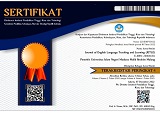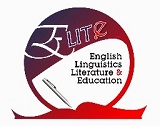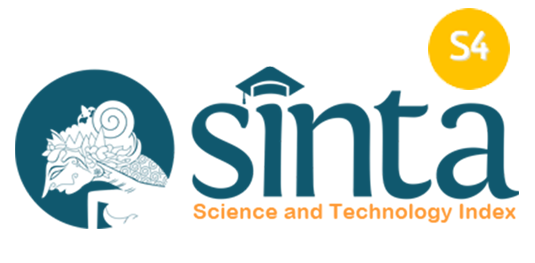A review on digital multimodal composing in post-secondary EFL context: Practices and implications
Abstract
The availability of texts and how they are produced have become more multimodal, along with the rapid development of technology. In the English as Foreign Language (EFL) context, this change has influenced classroom instructions where digital multimodal composing (DMC) is incorporated into students’ meaning-making. This qualitative study aims to review recent studies on DMC in the post-secondary EFL contexts to find out the DMC tasks implemented in this setting and what implications have resulted from the tasks. Based on the analytical review of twenty empirical studies from 2015-2022, DMC was generally used to leverage students’ English language skills, train students’ digital literacy skills, advocate students’ voices, build learning engagement and investment, and increase students’ participation in collaborative projects. The implication of the studies showed that teacher support is needed and that the DMC tasks afford to expand students’ meaning-making. Future direction on DMC studies in the post-secondary EFL context is also discussed.
Keywords
Full Text:
PDFReferences
Balaman, S. (2018). Digital storytelling: A multimodal narrative writing genre. Journal of Language and Linguistics Studies, 14(3), 202-212.
Chen, C. (2018). Developing EFL students’ digital empathy through video production. System, 77, 50-57, doi: https://doi.org/10.1016/j.system.2018.01.006
Cheung, A. (2022). Verbal and on-screen peer interactions of EFL learners during multimodal collaborative writing: A multiple case study, 58, 1-16, doi: https://doi.org/10.1016/j.jslw.2022.100931
Christopher, A. (2021). Developing empathy in the digital age: Filmmaking projects in the Japanese context. Journal of Interactive Learning Research, 32(3), 227-244.
Cope, B., Kalantzis, M., & Abrams, S.S. (2017). Multiliteracies: Meaning-making and learning in the era of digital text. In F. Serafini & E. Gee (Eds), Remixing Multiliteracies: Theory and Practice from New London to New Times. Teacher College Press, 35-49.
Greenblatt, P., & Donald, P. (2022). Using multimodal public service announcement video projects as communicative language assessments. RELC Journal, 1-8.
Hafner, C. (2015). Remic culture and English language teaching: the expression of learner voice in digital multimodal compositions. TESOL Quarterly, 49(3), 486-509.
Hafner, C. (2020). Digital multimodal composing: How to address multimodal communication forms in English language teaching. English Teaching, 75(3), 133-146, doi: https://doi.org/10.15858/engtea.75.3.202009.133
Hung, S. (2019). Creating digital stories: EFL learners’ engagement, cognitive, and metacognitive skills. Educational Technology & Society, 22(2), 26-37.
Jewitt, C. (2008). Multimodality and literacy in school classrooms. Review of Research in Education, 32, 241-267. doi: http://doi.org/10.3102/0091732X07310586
Jiang, L., Yang, M., & Yu, S. (2020). Chinese ethnic minority students’ investment in English learning empowered by digital multimodal composing. TESOL Quarterly, 54(4), 954-979.
Jiang, L., Yu, S., & Zhao, Y. (2019). Incorporating digital multimodal composing through collaborative action research: Challenges and coping strategies. Technology, Pedagogy, and Education, 31(1), 45-61, https://doi-org.proxy.lib.ohio-state.edu/10.1080/1475939X.2021.1978534
Jiang, L. (2018). Digital multimodal composing and investment change in learners’ writing in English as a foreign language. Journal of Second Language Writing, 40, 60-72, doi: https://doi.org/10.1016/j.jslw.2018.03.002
Jiang, L. (2022). Facilitating EFL students’ civic participation through digital multimodal composing. Language, Culture, and Curriculum, 35(1), 102-117, doi: https://doi.org/10.1080/07908318.2021.1942032
Kim, Y., & Belcher, D. (2020). Multimodal composing and traditional essays: Linguistic performance and learner perceptions. RELC Journal, 5(1), 86-100, doi: http://doi.org/10.1177/0033688220906943
Lee, Y. (2019). Integrating multimodal technologies with VARK strategies for learning and teaching EFL presentation: An investigation into learners’ achievement and perception of the learning process. Australian Journal of Applied Linguistics, 2(1), 17-31.
Li, M., & Akoto, M. (2021). Review of recent research on L2 digital multimodal composing. International Journal of Computer-Assisted Language Learning and Teaching, 11(3), 1-16, doi: https://doi.org/10.4018/IJCALLT.2021070101
Li, M. (2022). Three heads are better than one? Digital multimodal composition completed collaboratively versus individually, Language Teaching Research, 1-22, doi: https://doi.org/10.1177/13621688221102536
Lin, V., Lin, Y., Hsieh, M., Liu, G., and Koong, H. (2021). The design and evaluation of a multimodal ubiquitous learning application for EFL writers. Digital Creativity, 32(2), doi: https://doi.org/10.1080/14626268.2021.1885449
Lo, Y., Lee, S., & Tien, W. (2020). Transforming a magazine into a video involving a target audience: A multiliteracies case study in an EFL context. Educational Technology & Society, 23(3), 27-39.
Lotherington, H. & Jenson, J. (2011). Teaching multimodal and digital literacy in L2 settings: New literacies, new basics, new pedagogies. Annual Review of Applied Linguistics, 31, 226-246, doi: https://doi.org/10.1017/S0267190511000110
Rinda, R. K., Indrastana, N. S., Pramudita, R. F., Rohmana, W. I. M., & Suryanto, P. J. L. (2022). Cascading a New Knowledge: The Implementation of Reference Management Software in The Academic Writing Class. Journal of English in Academic and Professional Communication, 8(2), 71–77. https://doi.org/10.25047/jeapco.v8i2.3883
Schmidt, N. (2019). Digital multimodal composition and second language teacher knowledge. TESL Canada Journal, 36(3), 1-30.
Seau, L., Azman, H., & Noor, N. (2018). A responsive pedagogical initiative for multimodal oral presentation skills: An action research study. 3L: the Southeast Asian Journal of English Language Studies, 24(2), 29-42.
Serafini, F. & Gee, E. (2017). Introduction. In F. Serafini & E. Gee (Eds), Remixing Multiliteracies: Theory and Practice from New London to New Times. Teacher College Press.
Shen, X., Hao, C., & Peng, J. (2022). Promoting EFL learners’ willingness to communicate through transmediation in a digital storytelling workshop. Journal of Multilingual and Multicultural Development, 1-18.
Smith, C. (2021). One does not simply teach idioms: Meme creation as innovative practice for virtual EFL learners. RELC Journal, 1-15, doi: https://doi.org/10.1177/00336882211044878
Xu, Y. (2021). Investigating the effects of digital multimodal composing on Chinese EFL learners’ writing performance: a quasi-experimental study. Computer Assisted Language Learning.
Yeh, H. (2018). Exploring the perceived benefits of the process of multimodal video making in developing multiliteracies. Language Learning & Technology, 22(2), 28-37, doi: https://doi.org/10125/44642
Yeh, H., Heng, L, and Tseng, S. (2021) Exploring the impact of video making on students’ writing skills. Journal of Research on Technology in Education, 53(4), doi: https://doi.org/10.1080/15391523.2020.1795955
Yeh, S. (2021). Collaborative writing on Google Docs: Taiwanese students’ participation, behavior, and writing trajectories with real-work online tasks. Advances in Language and Literacy Studies, 12(3), 74-81.
Yi, Y., & Angay-Crowder, T. (2016). Multimodal pedagogies for teacher education in TESOL. TESOL Quarterly, 50(4), 988-988.
Yu, B., & Zadorozhnyy, A., (2022). Developing students’ linguistic and digital literacy skills through the use of multimedia presentations. ReCALL, 34(1), 95-109, doi: https://doi.org/10.1017/S0958344021000136
Yuliani, F. (2022). Multimodal Learning Material in An English-Speaking Class in Kampung Baluwarti. JETLe (Journal of English Language Teaching and Learning), 3(2), 25–31. https://doi.org/10.18860/jetle.v3i2.15878
Zhang, M., Akoto, M., & Li, M. (2021). Digital multimodal composing in post-secondary L2 setting: a review of empirical landscape. Computer Assisted Language Learning, 36(4), 694-721, doi: https://doi.org/10.1080/09588221.2021.1942068
Zenouzagh, Z. (2022). Student interaction patterns and co-regulation practices in text-based and multimodal computer mediated collaborative writing modalities. Education Tech Research Development, doi: https://doi.org/10.1007/s11423-022-10158-0
DOI: https://doi.org/10.18860/jetle.v4i2.20664
Refbacks
- There are currently no refbacks.
Jalan Gajayana 50 Malang 65144, Jawa Timur, Indonesia

This work is licensed under a Creative Commons Attribution-ShareAlike 4.0 International License.
Indexed by





